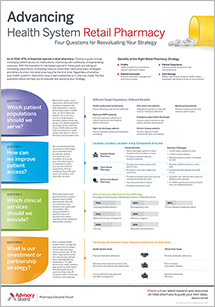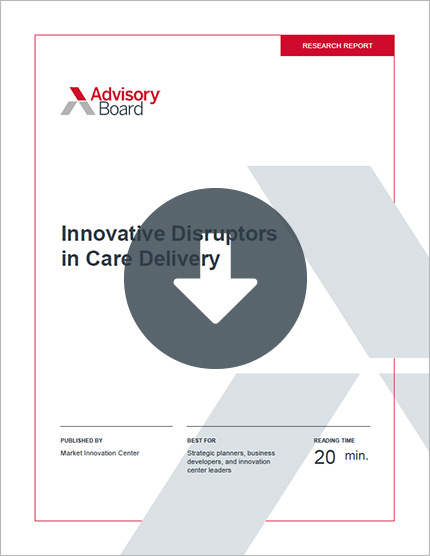Auto logout in seconds.
Continue LogoutA new generation of specialty health care services is entering retail spaces, as providers continue to shift away from high-overhead sites such as hospitals and toward offering lower-cost, more convenient care to patients.
The shift toward retail spaces
For nearly two decades, walk-in medical clinics and urgent care centers have been opening up in mall spaces or other locations vacated by retail stores.
According to a 2016 RAND research brief, the first retail medical clinics opened in 2000, and since then, they've grown rapidly. Accenture estimates there were 2,800 medical clinics in retail spaces in the United States in 2017, a significant increase from just 351 in 2006. If the trend continues, according to a report from services professional services firm JLL, the number of health clinics in retail spaces could almost double by 2022.
The next generation of retail clinics
But lately, health systems have expanded the types of services offered by retail clinics, enabling patients to access more specialized treatment—such as infusions, cancer care, and mental health care—in retail settings.
For example, Boston-based Beacon Health Options in November 2018 opened the first mental health retail clinic in a Walmart store.
In February 2018, Dana-Farber Cancer Institute announced its plans to lease about 34,000 square feet of retail space at a shopping center in Massachusetts to offer patients cancer treatment and hematology services in the same place they shop for clothes and dine. That same shopping center already is home to the Brigham and Women's/Mass General Care Center, which provides urgent care, cardiology, dermatology, pain management, rehabilitation, and other services.
Why the shift is happening
Observers say the latest shift toward specialty retail medical clinics stems from the same changing health care dynamics that pushed walk-in clinics and urgent care centers into consumer shopping zones, such as changing consumer preferences, initiatives to lower health spending, and technological advances.
Each of these factors has led health systems, which traditionally focused on inpatient revenue, to make outpatient revenue part of their strategic plans. And retail clinics enable health care executives to deliver convenient, accessible care with consistent branding and high visibility, according to JLL.
According to Greg Hagood, senior managing director for SOLIC Capital, many prominent physician groups also are looking to lower costs by shifting away from hospital campuses to off-campus retail settings that typically have cheaper rent and are more convenient for patients.
"It's the Walmart or Kmart that went out of business," he said. "You pull right up. The parking is easy. The patient is likely to come more often."
These health clinics are also attractive to retail landlords, JLL's report said, as physician and hospital groups tend to be willing to take on longer leases.
Will the retail shift actually cut costs?
This shift toward retail settings is seen by many as a way to increase access to care while cutting costs, Modern Healthcare reports.
But not everyone agrees that retail clinics will succeed in that mission. A 2016 Health Affairs study, for instance, found that 58% of retail clinic visits were for low-acuity conditions that represented new utilization—that is, patients who would not otherwise have sought medical care at all for their condition. Further, usage of these clinics was associated with a $14 per person annual increase in spending.
And some experts warn that providers may find it difficult to offer specialty care in retail locations. For example, Gary Chinman, president of the Massachusetts Psychiatric Society, said Beacon Health "would have to change a lot more about their business model" for the Walmart clinic to be successful.
Chinman said the company can sometimes require multiple authorizations that can present barriers to care (Bannow, "Transformation Hub," Modern Healthcare, 5/22; Owens, "Vitals," Axios, 5/24).
Next, learn how progressive organizations are "retailizing" their service lines
With patients increasingly self-referring and influencing their specialty care referrals, primary care physicians are no longer the sole players in directing specialty care volumes. In fact, self-referrers now drive up to half of specialty business.
Learn how progressive organizations are “retailizing” their service lines by engaging potential patients through symptom-focused messaging, cultivating a word of mouth strategy, providing fast access for select parts of the care pathway, and creating a targeted pricing strategy.
Don't miss out on the latest Advisory Board insights
Create your free account to access 1 resource, including the latest research and webinars.
Want access without creating an account?
You have 1 free members-only resource remaining this month.
1 free members-only resources remaining
1 free members-only resources remaining
You've reached your limit of free insights
Become a member to access all of Advisory Board's resources, events, and experts
Never miss out on the latest innovative health care content tailored to you.
Benefits include:
You've reached your limit of free insights
Become a member to access all of Advisory Board's resources, events, and experts
Never miss out on the latest innovative health care content tailored to you.
Benefits include:
This content is available through your Curated Research partnership with Advisory Board. Click on ‘view this resource’ to read the full piece
Email ask@advisory.com to learn more
Click on ‘Become a Member’ to learn about the benefits of a Full-Access partnership with Advisory Board
Never miss out on the latest innovative health care content tailored to you.
Benefits Include:
This is for members only. Learn more.
Click on ‘Become a Member’ to learn about the benefits of a Full-Access partnership with Advisory Board
Never miss out on the latest innovative health care content tailored to you.


